This page includes both hexagonal patterns and hexagonal blocks.
 Honey-comb  Varie-
gated Hexagon
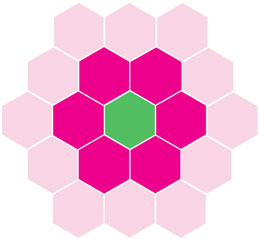 Grand-mother's Flower Garden 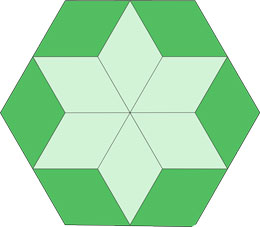
Godey's hexagon  Whirling Diamonds 
Whirligig Hexagon 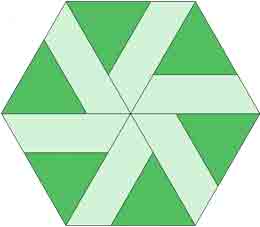
Texas Trellis 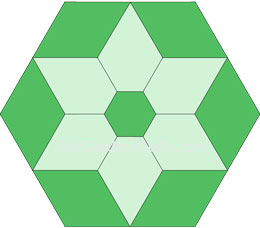
Dolly Madison Hex 
The Flower Garden
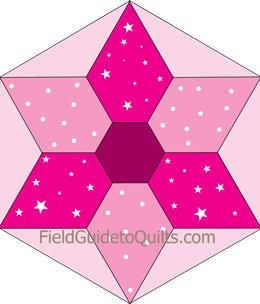
Six-point Flower Garden  3D Hexagon
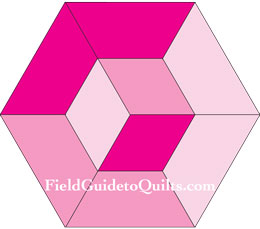 3D Hexagon variation

Ozark Diamond  Ma Perkins' Flower Garden  French Bouquet
 Star Center on French Bouquet 
Snow Crystal 
Periwinkle
A spacer
|
|
Honeycomb
 Honeycomb Honeycomb
We're told that if you put your hand in a bag of hex blocks and pick each successive block without looking, you'll get a random pattern that works just as well as anything an artist could devise.
|
|
Variegated Hexagon
 Variegated Hexagon Variegated Hexagon
Farm & Home
ca. 1890 Like Honeycomb, variegated hexagon is simply an arrangement of hexagons, but they're divided into light and dark fabrics set in rows. According to Jinny Beyer, this quasi-block was published about 1890 in Farm and Home. |
|
Grandmother's Flower Garden
 Grandmother's Flower Garden
Grandmother's Flower Garden
|
 Grandmother's Flower Garden Grandmother's Flower Garden |
|
French Bouquet
 French Bouquet
Foland, KCS, 1931 French Bouquet
Foland, KCS, 1931
The whole-quilt mockup (click on the graphic) shows an alternative color scheme. |
 French Bouquet in five colors French Bouquet in five colors |
 French Bouquet in six colors French Bouquet in six colors |
|
Texas Trellis
 Texas Trellis
KCS, 1943
Texas Trellis
KCS, 1943
The mockup shows why: When all the hexagons are in the same colors, the hexagons meld, obscuring the honeycomb pattern.
Every last one of the hex blocks is made up of triangles like this:  It's like a slice of pie with a very thick crust. The crust can be thick or thin, as long as it's the same on every slice. It's like a slice of pie with a very thick crust. The crust can be thick or thin, as long as it's the same on every slice.
|
 Texas Trellis Texas Trellis |
|
Godey's hexagon
 Godey's hexagon
Godey's Lady's Book 1851
Godey's hexagon
Godey's Lady's Book 1851 |
 Godey's hexagon Godey's hexagon |
|
Dolly Madison Hex
 Dolly Madison Hex
Dolly Madison Hex
LAC, 1922
This block only dates back to 1922, but it
has more names than the Queen of England.
Dolly Madison's Pattern was the Kansas City Star's name for it in 1937. Of the other names, two are shared: The LAC's Texas Star (1922), is also used for a multi-ring diamond star, and Home Art's name, Dolly Madison Star (we don't know the date), also stands for an Ohio Star variation.
A volley of snores suits the rest: Nancy Page's Hexagon Stars and Friendship Hexagon, as well as the magazine Hearth & Home's Hexagonal Stars.
The Star published it twice in the 1950s, calling it The Star Garden in 1954 (it credited a Missouri reader for the design) and, finally, A Garden of Flowers in 1956. At that point, the Star noted, it was also known as the Dolly Madison quilt block. |
 Dolly Madison Hex Dolly Madison Hex
|
|
|
|
Seven Stars/Whirling Diamonds

Whirling Diamonds
|
 Whirling Diamonds Whirling Diamonds
|
|
|
The Flower Garden/Six-point Flower Garden
 The Flower Garden/Six-point Flower Garden
KCS, 1937
The Flower Garden/Six-point Flower Garden
KCS, 1937
 Six-point Flower Garden
Six-point Flower Garden
KCS, 1938
The only difference between these two blocks is in the color placement: The Flower Garden has three colors; Six-point Flower Garden has four.
The Flower Garden was published in the Star in 1937 and 1951. Six Point Flower Garden was in the Star in 1938.
Both blocks differ from the Dolly Madison Pattern.
Between each of the Dolly Madison's outer points is a diamond patch; in these two blocks it's a triangle.
|
 Six-point Flower Garden Six-point Flower Garden  The Flower Garden The Flower Garden |
|
French Bouquet
 French Bouquet
Foland, KCS, 1931 French Bouquet
Foland, KCS, 1931
The whole-quilt mockup (click on the graphic) shows an alternative color scheme. |
 French Bouquet in five colors French Bouquet in five colors |
 French Bouquet in six colors French Bouquet in six colors |
|
Snow Crystal/Star Center on French Bouquet
 Snow Crystal
Dunn, KCS, 1932
Snow Crystal
Dunn, KCS, 1932
 Star Center on
Star Center on
French Bouquet
KCS, 1934
In 1957, when the KCS published it as Star Center on French Bouquet, the double triangles (mediium pink in our graphic) had been combined as a single piece. That seems to simplify the block, but in fact it makes the block trickier to piece. In the earlier design, you could piece the entire block together as hexagons.
You'll note from the whole-quilt mockup that you'll need blocks in at least three different colors to avoid having the blocks' colors touch.
hexagons. |
 Snow Crystal/Star Center on French Bouquet Snow Crystal/Star Center on French Bouquet
|
|
Ozark Diamond/Ma Perkin's Flower Garden
 Ozark Diamond
Foland, KCS, 1931
Ozark Diamond
Foland, KCS, 1931
 Ma Perkins' Flower Garden
KCS, 1936
Ma Perkins' Flower Garden
KCS, 1936
Five years later, the Star replaced the Ozark Diamond's outer pieces with triangles and republished the block as Ma Perkin's (sic) Flower Garden, named for the beloved 1933 radio drama Oxydol's Own Ma Perkins. Ma Perkins was a generous-hearted widow who co-owned and ran a lumber mill in a country village. The show revolved around Ma's children and her conversations about life with the mill's other owner, Shuffle Shober.
The radio show ran until 1960, clocking more than 7,000 episodes of 15 minutes each. Only on the last broadcast was Ma Perkins revealed to be (gasp!) an actress.
|
 Ozark Diamond Ozark Diamond |
 Ma Perkins' Flower Garden Ma Perkins' Flower Garden |
|
3D Hexagon
 3D Hexagon
TeresaDownUnder
3D Hexagon
TeresaDownUnder
2017
 3D Hexagon variation
3D Hexagon variation
If you don't mind doing Y seams, you can make the cube shape a bit more prominent by turning each pair of center triangles into a diamond.
|
 3D Hexagon (TeresaDownUnder) 3D Hexagon (TeresaDownUnder) |
|
Crazy Tile Quilt

Crazy Tile Quilt
KCS, 1939
Here's an example in friendlier hues: 
To make the most of this design, you really do need six contrasting fabrics arranged just like the KCS block.
You'll notice that the block is made up of half-hexagons. For
two more blocks that incorporate half-hexagons, click here:  |
 Crazy Tile Quilt Crazy Tile Quilt |
|
Periwinkle
 Periwinkle
Periwinkle
|
 Periwinkle Periwinkle Periwinkle Periwinkle |
 Hexagons
Hexagons  Honeycomb
Honeycomb Variegated Hexagon
Variegated Hexagon  Grandmother's Flower Garden
Grandmother's Flower Garden French Bouquet
French Bouquet French Bouquet in five colors
French Bouquet in five colors  French Bouquet in six colors
French Bouquet in six colors  It's like a slice of pie with a very thick crust. The crust can be thick or thin, as long as it's the same on every slice.
It's like a slice of pie with a very thick crust. The crust can be thick or thin, as long as it's the same on every slice.  Texas Trellis
Texas Trellis
 Godey's hexagon
Godey's hexagon Dolly Madison Hex
Dolly Madison Hex Whirling Diamonds
Whirling Diamonds Six-point Flower Garden
Six-point Flower Garden  The Flower Garden
The Flower Garden  French Bouquet
French Bouquet French Bouquet in five colors
French Bouquet in five colors  French Bouquet in six colors
French Bouquet in six colors  Snow Crystal/Star Center on French Bouquet
Snow Crystal/Star Center on French Bouquet  Ozark Diamond
Ozark Diamond Ma Perkins' Flower Garden
Ma Perkins' Flower Garden 3D Hexagon (TeresaDownUnder)
3D Hexagon (TeresaDownUnder) Crazy Tile Quilt
Crazy Tile Quilt
 Periwinkle
Periwinkle Periwinkle
Periwinkle














